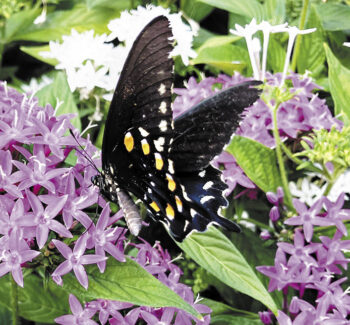
Monarch Butterfly at SaddleBrooke Ranch
Bob Allen, Master Gardener
Butterflies need our help! How to help them was what over 100 interested gardeners learned on Sept. 11 at a seminar hosted by the Southeast Pinal County Master Gardeners at SaddleBrooke Ranch. Katie Rogerson, Director of Education and Public Engagement at Tucson Botanical Gardens, taught this fascinating lecture.
Most of the plants supporting butterflies are shrubs, trees, vines, grasses, and ground covers. Most are native to the Sonoran Desert or are non-invasive exotics from arid regions that are no threat to native plant communities. The presentation included 29 species of butterflies most seen in Southwestern Gardens and information about what plants attract them, butterfly life cycles, and what we can do to encourage them.
Let’s start with a butterfly garden. You’ll want to create a stepped effect with tall plants in the back and low growers in the front. If your garden is circular, tall plants in the center tapering down in plant size to the lowest growing plants in the perimeter. Keep low-water plants together, if possible, and limit the use of plants that require more water.
Locate the garden in a sunny area easily accessible so you can observe butterflies. Provide some shade if none exists. An effective butterfly garden will include both butterfly nectar flowers and larval foodplants. Nectar should be available most of the year. Try observing butterflies at local nurseries or at Tucson Botanical Gardens for butterfly garden ideas.
Avoid using pesticides and other chemicals because these will kill caterpillars and adults. Adult butterflies are most active from spring to fall on warm, sunny days. Expect daily and seasonal fluctuations in the numbers of butterflies visiting your garden or container garden. Pots work well if you don’t have a yard!
Butterflies are easily the most noticed, well-liked, colorful, and benign insects. Nearly 400 species occur in the Southwest, more than half of the total number in all North America!
Did you know that Arizona has a state butterfly? It is the Two-Tailed Swallowtail. They are the largest species of butterflies in the United States.
Monarch Butterflies depend on healthy populations of milkweed. Other butterflies depend upon larval foodplants. If you have an herb or vegetable garden, you may have encountered a few of the strikingly colored Black Swallowtail caterpillars. Just pick them off if there are too many, but remember they need to eat if you want butterflies. They will cause some damage, but they will not kill the plant.
Native shrubs are drought tolerant and bloom from spring to fall, usually in response to rain or irrigation. Butterflies of all species love them. How about a Red Bird of Paradise? Adding this to your garden can attract some of the larger, showier species. One butterfly sure to come is the Pipevine Swallowtail. This black, orange, and iridescent blue species is one of the largest and most conspicuous of Southwestern Butterflies.
Trailing Lantana is an excellent addition to your butterfly garden. This nectar source draws all kinds of butterflies, and many will often favor it over other flowers.
In 2022, the International Union for Conservation of Nature declared the migratory Monarch Butterfly as endangered. Monarch populations are declining due to habitat loss, eradication of the plants it depends upon, and environmental factors.
You can help by joining Tucson Botanical Gardens’ Monarch Waystation program. To offset the loss of milkweeds and nectar sources we need to create, conserve, and protect Monarch butterfly habitats. Creating a Monarch Waystation can be as simple as adding milkweeds and nectar sources to your existing garden or maintaining a natural habitat with milkweeds.
To qualify as a registered Monarch Waystation through “Monarch Watch,” plant at least 10 milkweeds of varying species, particularly those native to Arizona. Include other host plants and nectar plants to draw a variety of other butterflies to your garden. We recommend native plants from a local nursery when available.
